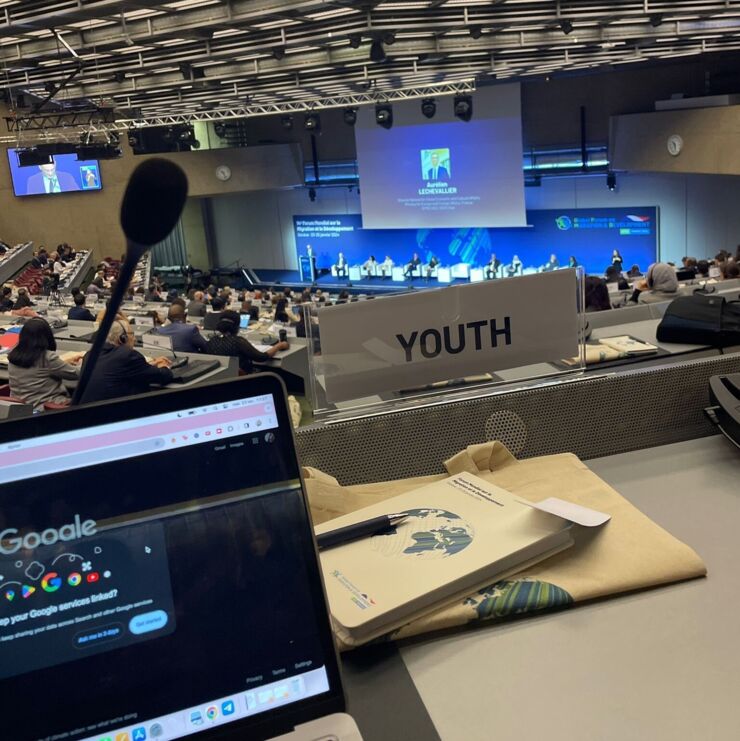It is January 2024, and the Global Forum for Migration and Development Summit is taking place in Geneva, Switzerland. Representatives of governments and interest groups have come to talk about refugees, labour migration, human rights and everything that involves large movements of people.
Everybody is there.
No, that is not true. The Swedish government, for example, refuses to participate. This is the first time in the history of the summit.
“It fits into a pattern. Some others didn’t show up either. The UK sent a rather young delegation. That’s a diplomatic signal that they don’t attach as much value to the summit as before,” says Associate Professor Jonathan Josefsson at the Department of Thematic Studies − Child Studies (TEMAB) at Linköping University.
Observations and conversations
The Global Forum for Migration and Development (GFMD) was first held in 2007. It was initiated by countries and organisations that saw a need for a common platform to The conference was held in Geneva. Photo credit Jonathan Josefsson discuss migration at the highest level, but without negotiations or binding agreements.
According to Jonathan Josefsson, Sweden and its conservative government under Fredrik Reinfeldt took an active role in international migration policy in 2006–2014. But as early as under the subsequent Social Democratic-led government, interest seemed to decline and this time the Swedish government was not even represented.
Jonathan Josefsson participated together with his colleague Branka Likic-Brboric, senior associate professor at the Division of Migration, Ethnicity and Society (REMESO). They both research factors that govern global migration. At meetings like the one in Geneva, they say, things that are not visible in official documents, agreements or speeches are revealed.
“My primary mission was to collect data. I did interviews and tried to follow the course of the meeting, how different actors interacted with each other and what was on the agenda,” says Jonathan Josefsson.
Fewer seats for civil society
France, the host country, had for example chosen to reduce the number of seats for civil society from 250 to 120. A contributing factor to this may have been that Germany, which previously contributed funding, has now chosen not to give any money. This meant that many were not allowed in. Also, in the meeting rooms where the talks were to be conducted, the number of seats for civil society had been cut sharply.
The number of seats for civil society organisations had beend reduced Photo credit Jonathan Josefsson
“But just as the meeting started, the doors of several of the most central meeting rooms were suddenly opened for civil society. This was probably due to pressure from the organisations − that they threatened to protest in different ways, such as sit-ins and the like,” says Jonathan Josefsson.
But Branka Likic-Brboric thinks that there were also advantages to the fact that the summit was smaller and had fewer participants, as this made it easier to make contact and have discussions.
 More young people had the chance to attend. Photo credit Jonathan Josefsson Youth representation
More young people had the chance to attend. Photo credit Jonathan Josefsson Youth representation
And as usual, reality is not uniform. Compared to previous conferences, for example young people were more represented and the United States had sent a relatively heavyweight delegation. In total, more than 100 countries were represented.
Since 2018, a new framework and meeting forum has also been established under the auspices of the UN called the Global Compact for Migration. The participating countries have committed to 23 global migration targets. These will be followed up every four years.
“The Swedish government says that this process is a priority instead. The problem is that it has more limitations. For example, researchers and civil society representatives are much more excluded. Of course, there are commitments and targets, but these are currently of a very general nature,” says Jonathan Josefsson.
According to him, summits such as the one in Geneva will therefore be important meeting places for the exchange of knowledge between researchers, independent organisations and government representatives. That is why the United States and over a hundred other countries considered it important to attend.
Some themes discussed were migrants’ right to health, health care and a dignified life, but also the opportunities that can arise from migration. The African countries talked about how to make it easier for people to work in other countries on the continent as a way to solve labour shortages.
Political disinterest
In Sweden, the debate on migration has mostly come to be about crime and social problems, and the politicians’ response has been stricter laws and regulations. Neither Jonathan Josefsson nor Branka Likic-Brboric feel that politicians are particularly interested in what research says.
“Take the proposal on the obligation to provide information, that public sector employees would have an obligation to report undocumented migrants. The politicians say that this is in order to reduce the “shadow society” of irregular migrants living in Sweden, but research and experience show that it would have the opposite effect,” says Jonathan Josefsson.
Branka Likic-Brboric does not believe that migration should be idealised or demonised. She calls for a more multifaceted picture, for example to explain the emergence of gang criminality. In her view, blaming it solely on migration is simplified.
“A lot has changed in society over the past three decades. Globalisation, technological change, socio-economic and political transformations, unemployment and, not least, growing inequalities between and within countries are the main causes of migration.”
Translation: Anneli Mosell


